In Utah there are around 27 lizard species that you may find. Across Utah you can find environments like forests, deserts, wetlands, and grasslands. Lizards are important members within their ecosystem. They help control the populations of pest invertebrates, and are also used as food for larger carnivores.
You can find a variety types of lizards that live in the state, each preferring their own habitat, and having their own appearance. How a lizard looks, acts, and where it lives can all be useful in identifying a species.
Here we will look at the 27 lizard species that live in Utah, and go over the useful facts that you should know about them. Some of the lizards in the state are very rare, while others can be very common.
Table of Contents
Lizards in Utah
Scincidae
1. Western Skink
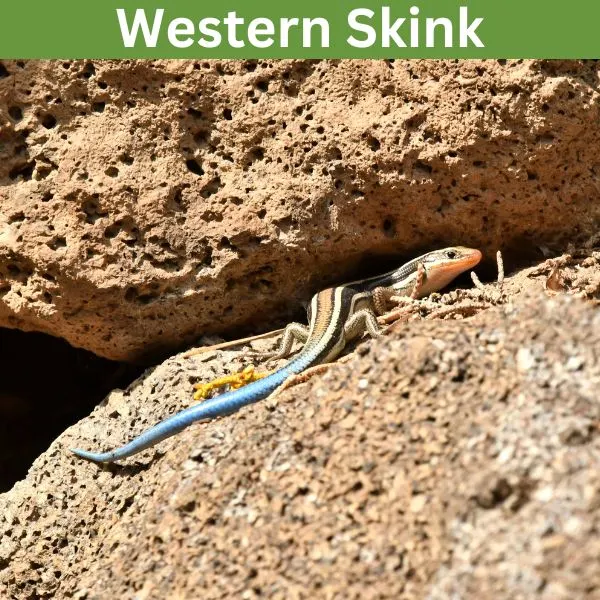
- Experience Level: Beginner
- Family: Scincidae
- Scientific Name: Plestiodon skiltonianus
- Other Names: n/a
- Adult Size: 4 to 8.25 in. (10.16 to 20.95 cm.)
- Lifespan: 10 years
- Average Price Range: n/a
Western skinks are native to the western United States, and can be found in the western area of Utah. Habitats like woodlands, grasslands,hillsides, and other similar habitats that are dry is where this lizard lives. Active in the day, they often hide within leaf litter, or around dense vegetation.
When born similar to other skinks, the western skink has a bright blue tail. These lizards have smooth scales, with tan, olive, or gray. Western skinks have dark stripes that run down their slides, with a slender body. In adults these lizards may lose their vibrant coloring and look more gray as they age.
Western skinks are a very common lizard in the Western United States, and have a stable population in Utah. These lizards feed on insects, and other small invertebrates in the day, while trying to hide from predators like birds, snakes, or larger lizards. Western skinks will run, drop their tail, or hide to avoid predators.
2. Many-lined Skink

- Experience Level: Beginner
- Family: Scincidae
- Scientific Name: Plestiodon multivirgatus
- Other Names: Variable Skink, Northern Many-lined Skink
- Adult Size: 3 to 7.5 in. (7.5 to 19 cm.)
- Lifespan: 6 years
- Average Price Range: n/a
Many-lined skinks are found in the southeastern corner of Utah. They are found in the western United States. These lizards live in habitats with sandy soils, wooded habitats, and open grasslands. Many-lined skinks are active in the day.
These lizards get their name from the many lines that run down their backs. They have smooth scales, with stripes that run down their head to tail. Olive, or tan are the colors of these species. Many-lined skinks that are male may have a red mark appear near their face.
These lizards have a stable population in their range. They breed in the spring, and lay their eggs under rocks. Many-lined skinks feed on small invertebrates like millipedes, grasshoppers, beetles, and ants. These species are listed as least concern by the IUCN, and their populations are stable.
Crotaphytidae
3. Eastern Collared Lizard

- Experience Level: Intermediate
- Family: Crotaphytidae
- Scientific Name: Crotaphytus collaris
- Other Names: Yellow-headed Collared Lizard
- Adult Size: 8 to 15 in. (20 to 38 cm.)
- Lifespan: 10 to 12 years
- Average Price Range: $70
Eastern collared lizards are native to the south-central United States, and are a species that can be found in Utah. Shrublands, open woodlands, desert, and grasslands are some of the habitats these lizards live in. Eastern collared lizards are very quick, and able to run up to 15 mph (24 kph).
Eastern collared lizards get their name from the black marking around their neck. Males of this species are much more colorful than females, and can have blue, or yellow markings on them. Females may appear more brown, or gray. These lizards have spots, and bar markings on them.
The day is when the eastern collared lizard is active, and in the mornings they are often seen basking in the sun. In spring these lizards mate, and lay around 4 to 6 eggs. Females that are large have a better chance of laying more eggs.
Insects, and small vertebrates like mice is what these lizards eat. They are very quick, and can run bipedally. Their speed is used to catch prey, or escape predators like hawks. Crevices, and thick vegetation is where these lizards hide.
4. Desert Collared Lizard
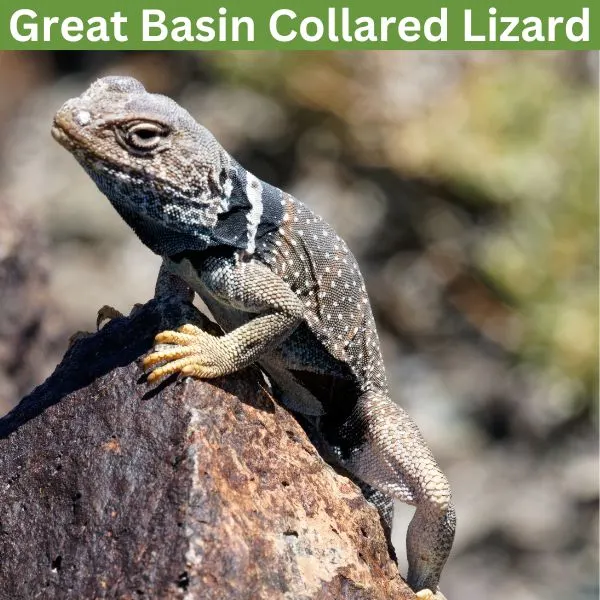
- Experience Level: Intermediate
- Family: Crotaphytidae
- Scientific Name: Crotaphytus bicinctores
- Other Names: Great Basin collared lizard
- Adult Size: 10 in.(25.4 cm)
- Lifespan: 5 to 8 years
- Average Price Range: $50
Desert collared lizards are native to Utah, and other nearby states in the western regions of the U.S. These lizards are found in most of Utah, but are absent in parts of the northeastern regions of the state. Deserts, and other semi-arid habitats is where these lizards live.
Desert collared lizards are named after their collared pattern around their neck that is black. These lizards have a brown, to orange coloring, with a pinkish, or red markings on their belly Females have a black, or brown coloring. These lizards have spots, blotches, and bands that appear on them.
They have a similar appearance to the other similar species in Utah, the eastern collared lizard, but have a more dull appearance. Desert collared lizards feed on insects, spiders, and sometimes other small animals like lizards, small snakes, or rodents. These lizards have a stable population, and are a species of least concern by the IUCN.
5. Long-nosed Leopard Lizard

- Experience Level: Intermediate
- Family: Crotaphytidae
- Scientific Name: Gambelia wislizenii
- Other Names: n/a
- Adult Size: 3.25 to 5.75 in. (8.225 to 14.6 cm.)
- Lifespan: 5 to 8 years
- Average Price Range: $20
Long-nosed leopard lizards are found in semi-arid, plains, grasslands, and desert habitats. They are active in the day, and spend this time basking in the sun on rocks. The morning is when this lizard is seen the most.
These lizards are one of the largest in the state, and have a gray, or tan coloring. Long-nosed leopard lizards have dark spots that cover them, with bars on their tails. Females of this species are larger. The mating season is when these lizards may have brighter orange or reddish spots on them.
Long-nosed leopard lizards feed on smaller prey like other lizards, rodents, and insects. Cannibalism in this lizard sometimes occurs with their young. As ambush predators this lizard hides in a hidden area like in a tree, and uses their quick jaws to snatch them. The coloring of the lizard also helps them camouflage.
Teiidae
6. New Mexico Whiptail

- Experience Level: Advanced
- Family: Teiidae
- Scientific Name: Aspidoscelis neomexicanus
- Other Names: n/a
- Adult Size: 6.5 to 9.5 in. (16.51 to 24.13 cm.)
- Lifespan: 3 to 7 years
- Average Price Range: n/a
The New Mexico whiptail is a lizard found mostly in the southwestern United States. These lizards are mainly found in New Mexico, but there have been reports of populations establishing near Salt Lake City in Utah. New Mexico Whiptails live in desert, grasslands, and semi-arid environments.
New Mexico whiptails are long, with sender bodies. They have seven yellow stripes that run down their bodies. The underside of this species is pale, and they can have a blue color on their neck. Tan, or black are these lizards’ most common colors.
These lizards are an example of a species created by hybridization, and they are bred from the little striped whiptail (A. inornatus), and the western whiptail (A. tigris). There are only females of this species, and they breed through the asexual reproduction of Parthenogenesis.
These lizards feed on insects like moths, butterflies, ants, and grasshoppers. They ambush their prey, and are also very quick, which helps them escape predators. New Mexico whiptails are mainly active in the day from the spring to fall, and hibernate in the winter.
7. Western Whiptail

- Experience Level: Intermediate
- Family: Teiidae
- Scientific Name: Aspidoscelis tigris
- Other Names: n/a
- Adult Size: 9.8 to 13.7 in. (25 to 35 cm.)
- Lifespan: 7 years
- Average Price Range: n/a
Western whiptails live in the southwestern United States. These lizards live in woodlands, shrublands, deserts, and other similar habitats. Active in the day, they are found in places with sparse desert vegetation. In the extreme heat they use plants, and burrows to rest.
These lizards have a long and slender body. They have a tan, olive, or brown coloring, with a spotted, or striped pattern. In the breeding seasons these lizards may have reddish markings on their chins. When young western whiptails will have an orange, or yellow color with dark spots on them.
Western whiptails have both male and females, which is unlike the other species in their genus which are all female. These lizards lay their eggs in the summer, and they lay from one to six eggs.
Spiders, scorpions, grasshoppers, and other types of insects are what this species eats. They use their quick jaws to snatch up prey. If attacked western whiptails flee, and also drop their tail. Cats are typically the predator these lizards will drop their tail to distract them long enough for a hasty escape.
8. Plateau Striped Whiptail

- Experience Level: Intermediate
- Family: Teiidae
- Scientific Name: Aspidoscelis velox
- Other Names: n/a
- Adult Size: 2 to 5 in. (5 to 12.7 cm.)
- Lifespan: 7 years
- Average Price Range: n/a
Plateau striped whiptails are a species that lives in grasslands, and shrubland environments. A medium-sized species, all of these lizards are only female. They breed by parthenogenesis, and unfertilized eggs will turn into clones of the mother. Plateau striped whiptails not only inhabit Utah, but other nearby states like Colorado, Arizona, New Mexico, and Oregon.
These lizards have a slender body, with small limbs, and long toes. Their colors range from olive, gray, tan, or black. Yellow stripes run down this lizard, and their tail is as long as their body.
The day is when plateau striped whiptails are active, and they forage during the day on insects. These lizards get preyed on by bobcats, foxes, larger lizards, and large snakes. They are a very common species, able to produce lots due to their size.
Anguidae
9. Southern Alligator Lizard

- Experience Level: Intermediate
- Family: Anguidae
- Scientific Name: Elgaria multicarinata
- Other Names: n/a
- Adult Size: 3 to 7 in. (8 to 18 cm)
- Lifespan: 7 years
- Average Price Range: $350
Southern alligator lizards live in forests, open woodlands, grasslands, and urban areas. They are found in the western United States, but are very rare in Utah. This species is found more often in dry climates, but will live near a stream, or other water source.
The body of the southern alligator lizard is robust, but flat. They have a prehensile tail which they can move around, and are very long. Southern alligator lizards have brown, gray, olive, or yellowish coloring, which blotches on them. They have crossbands on their body.
Southern alligator lizards are sometimes found near human habitats, living in gardens, and under houses. These lizards mate in the spring, and lay their eggs in early summer. They often lay eggs in places like decaying wood, and in plant matter.
Southern alligator lizards have a stable population across their range. These lizards feed on small insects like beetles, ants, moths, and smaller lizards. Often kept as pets, they are a species that can be aggressive if handled.
Iguanidae
10. Common Chuckwalla

- Experience Level: Intermediate
- Family: Iguanidae
- Scientific Name: Sauromalus ater
- Other Names: n/a
- Adult Size: 16 in. (40 cm.)
- Lifespan: 15 to 65 years
- Average Price Range: $200
Common chuckwallas are a species native to the far southwestern regions in the United States. These lizards are found in the southern portions of Utah. They live in rocky deserts. In crevices within rock, or thick vegetation is where this lizard hides. Common chuckwallas are active in the spring to fall, and in winter hibernate within deep rock crevices.
These lizards are one of the largest reptiles in Utah, and have very big, round, and flat bodies. They have a tan, black, or gray coloring with very wrinkly skin. This lizard has a big broadhead. Tannish or red specks may appear on their body.
Mating for this lizard occurs in the late spring, or early summer. They can have up to 16 eggs, which hatch and grow in the fall. Across their native range this lizard has a stable population, but is not as common to find as other species.
11. Desert Iguana

- Experience Level: Intermediate
- Family: Iguanidae
- Scientific Name: Disposaurus dorsalis
- Other Names: n/a
- Adult Size: 16 inches (40 cm.)
- Lifespan: 10 to 16 years
- Average Price Range: $50
Desert iguanas are found in the Sonoran, and Mojave Deserts in North America within the southwestern United States. These lizards are very rare in Utah, and only seen in the far southwestern corner of the state. Desert iguanas live in desert habitats with lots of sand, and scrubland. They are capable of tolerating high temperatures, and use burrows when it gets too hot.
These lizards are medium-sized to large, and have a very long tail. Their colors range from tan, to black, and they may have tan spots on them. These lizards have roughly keeled scales, with a pale belly. In the breeding seasons these lizards may have pink markings on their sides.
Desert iguanas feed on insects, fruits, leaves, and the buds on plants. These lizards get most of the water they need from the food they eat. This lizard is able to drop its tail like other lizards to help them escape predators, and can run up to 30 mph. (48 kph). Large raptors, snakes, and foxes are these lizard predators in the wild.
Helodermatidae
12. Gila Monster

- Experience Level: Advanced
- Family: Helodermatidae
- Scientific Name: Heloderma suspectum
- Other Names: n/a
- Adult Size: 10.2 to 14.1 in. (26 to 36 cm)
- Lifespan: 20 to 36 years
- Average Price Range: $1,200
The Gila monster is a species that lives in the arid and desert regions of the southwestern United States. This includes parts of Arizona, Nevada, New Mexico, California, and Utah. In Utah these lizards are only found in the southwestern portions of the state.
Gila monsters are nocturnal, and are most active during the night. During the scorching day, gila monsters seek refuge in burrows or within rocks, emerging only when the temperature becomes more bearable. Their adaptation to this nighttime activity helps them conserve energy for the extreme habitat of the desert.
Gila monsters are recognizable by their stout, heavily built body. They are covered in vibrant orange or pinkish skin adorned with bold black bands or patches. These lizard scales are beaded, and bumpy. Their size makes them the largest lizards in Utah, but they are very rare to see and spend most of their life in burrows.
This coloration serves as a warning to potential predators, as Gila monsters are one of the few venomous lizard species in the world. They have venom glands in their lower jaw and deliver venom through grooved teeth. While the venom is not lethal to humans, a Gila monster bite can be painful and may require medical attention.
Gila monsters are carnivorous,and feed on insects, small mammals, birds, and eggs. Their slow metabolism allows them to go for extended periods without eating.
13. Common Side-blotched Lizard

- Experience Level: Beginner
- Family: Phrynosomatidae
- Scientific Name: Uta stansburiana
- Other Names: n/a
- Adult Size: 2.5 to 5 inches (6.35 to 12.7 cm.)
- Lifespan: 1 year
- Average Price Range: $12
The western United States is where the common side-blothced lizard lives, and this lizard can be found across North America. Common side-blotched lizards are found in dry environments. Deserts, and grasslands with sparse vegetation are common areas where this lizard lives.
This species gets its name from the dark blotch that appears on its side.They are a small species, with a tan, orangish, or yellowish color. Their bodies have roughly keeled scales on them, with males sometimes having blue markings covering them.
Common side-blotched lizards that are males can have a yellow, orange, or blue throat that tell how this species mates. The different mating styles of this lizard each have their own advantages. They average 5 eggs a clutch, but can lay up to 9 eggs.
Side-blotched lizards feed on insects like beetles, and grasshoppers, using their speed to chase down prey. These lizards will drop their tail, or rely on camouflage as their defenses.
14. Ornate Tree Lizard

- Experience Level: Beginner
- Family: Phrynosomatidae
- Scientific Name: Urosaurus ornatus
- Other Names: n/a
- Adult Size: 1.49 to 2.32 inches (3.8 to 5.9 cm)
- Lifespan: 3 years
- Average Price Range: n/a
Ornate tree lizards are found across the United States, which includes Utah. This species is found mainly in the southwestern United States, and is semi-arboreal. They are found in desert washes, riparian, and grasslands. They are able to adapt to several different types of climates.
These lizards are small, and come in various colors like tan, brown, gray, black, or rusty red. Males of this species have turquoise coloring under their chin, while females lack this trait. Their bodies have dark blotches on them, which help them blend into trees.
Insects and their larvae are what this lizard eats. These lizards are active for most of the year, but in the winter only come out on the warmest days. They will also sometimes eat plants and vegetables. This lizard uses trees, and shrubs to mate, and lay clutches through the year.
15. Plateau Fence Lizard
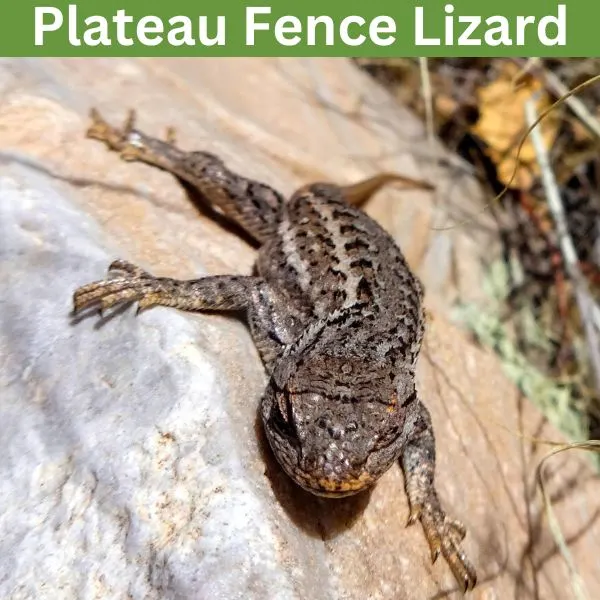
- Experience Level: Intermediate
- Family: Phrynosomatidae
- Scientific Name: Sceloporus tristichus
- Other Names: Pine lizard
- Adult Size: 4 to 7.5 in. (10 to 19 cm.)
- Lifespan: 5 to 7 years
- Average Price Range: n/a
Plateau fence lizards and found in Utah in rocky, semi-arid environments. They are also found in woodlands, urban areas, and grasslands. These lizards enjoy climbing and are seen on things like large rocks, fences, and the side of buildings.
Plateau fence lizards have tan, gray, or black coloring. They have roughly keeled scales, and in the breeding seasons these lizards will have a blue coloring on them. These lizards are small, and have colors that help them blend into wood, or dirt, with dark markings on their back.
Small invertebrates like insects, ants, and beetles are what this species eats, and they use their camouflage, and speed to ambush prey. In fallen tree trunks, and other vegetation is where this lizard often hides.
16. Yellow-backed Spiny Lizard

- Experience Level: Intermediate
- Family: Phrynosomatidae
- Scientific Name: Sceloporus uniformis
- Other Names: n/a
- Adult Size: 4 to 7 in. (10.16 to 17.78 cm.)
- Lifespan: 30 years
- Average Price Range: n/a
The yellow-backed spiny lizards live in Utah, and other nearby states in the western U.S. The Mojave and Great Basin deserts in North America are where this species lives. Semi-arid habitats like riparian, and sloped areas are where this species lives. They are active in the spring to fall months and hibernate in the winter.
Yellow-backed spiny lizards are small with males being larger than the female. Females of this species have a more pale appearance, while males can have a brighter appearance. Tan, yellow, or black are the colors on this lizard.
Ants, spiders, beetles, and other invertebrates are what this species eats. They are active in the day, and are often seen basking in the sun. Burrows are used for this species to rest at night, or hibernate in the winter.
17. Desert Spiny Lizard
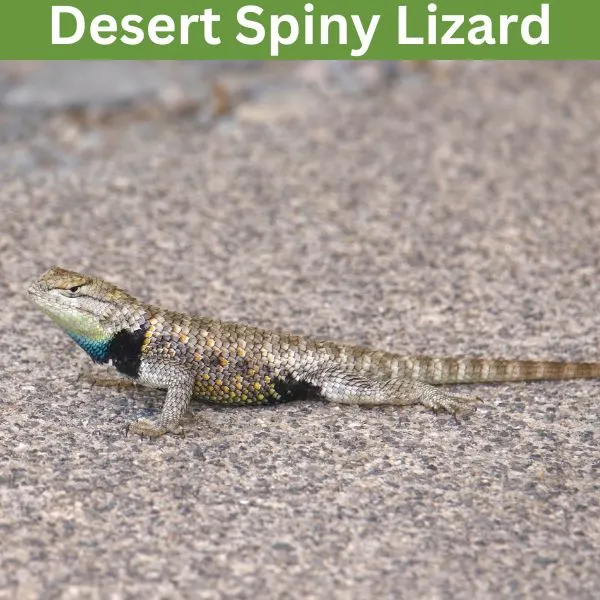
- Experience Level: Intermediate
- Family: Phrynosomatidae
- Scientific Name: Sceloporus magister
- Other Names: n/a
- Adult Size: 2.4 to 5.4 in. (6.3 to 13.8 cm)
- Lifespan: 2 to 7 years
- Average Price Range: $20
The desert spiny lizard is native to the western United States, found in Utah, California, Arizona, Texas, Nevada, and New Mexico. This lizard is found in the Sonoran, and Chihuahuan deserts of North America. They are very abundant, and have a stable population in their range.
Scales of this lizard are very keeled, and have a tannish color. Males of this species are very colorful, with blue bellies, and green blue scales on their sides. They also have yellow spots on them, while females are typically darker.
Desert spiny lizards are able to change their shade to absorb more heat from the sun. They breed in the spring, and lay around 4 to 26 eggs, which hatch later in the summer.
Ants, beetles, spiders, centipedes, and smaller lizards are some of the prey this lizard eats. They are active for most of the year except winter, and are a terrestrial species.
18. Western Fence Lizard

- Experience Level: Intermediate
- Family: Phrynosomatidae
- Scientific Name: Sceloporus occidentalis
- Other Names: Blue-belly lizard
- Adult Size: 4 to 7.5 in. (10 to 19 cm.)
- Lifespan: 5 to 7 years
- Average Price Range: $20
The western fence lizard lives in western region of the United States, which includes Utah. These lizards are found in western Utah, and live in habitats like woodlands, farmlands, and grasslands. They live from sea level, up to 10,800 ft. (3,291 meters). Deserts, and very hot habitats is where these lizards typically avoid.
Western fence lizards have roughly keeled scales, with gray to tan coloring. They are known from their bright blue coloring that appears on their belly, and males sometimes have extremely blue coloring that even appears on their body. These lizards are small, and very quick.
Urban areas near homes, and houses are common places this lizard lives. They are often seen during the day on the sides of houses, or on fences. Insects like spiders, ants, and lizards make up most of their diet.
19. Common Sagebrush Lizard
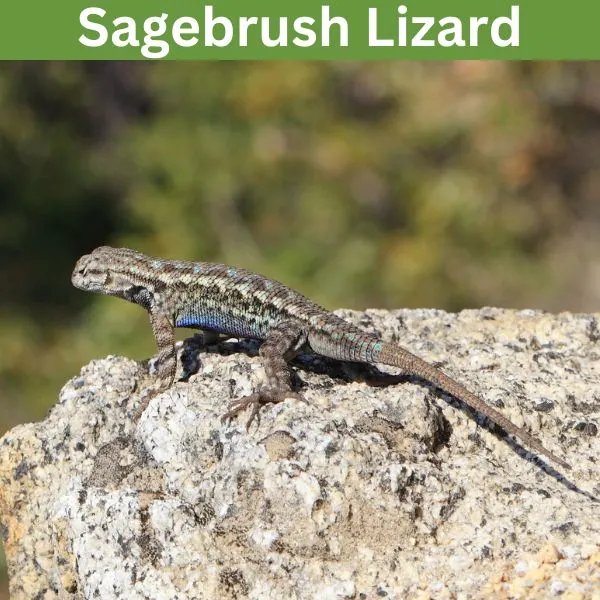
- Experience Level: Intermediate
- Family: Phrynosomatidae
- Scientific Name: Sceloporus graciosus
- Other Names: Sagebrush swift
- Adult Size: 2 to 5.9 in. (5 to 14.98 cm.)
- Lifespan: 5 years
- Average Price Range: n/a
The sagebrush lizard is native to the western United States, and can be found all across Utah. Forests, woodlands, rocky areas, and shrublands are common habitats where this lizard lives. Common sagebrush lizards are often found near higher elevations, and studies show these lizards grow quicker than ones that live in lower regions.
Common sagebrush lizards are a smaller, to medium-sized species, with tan coloring. They have a plain white underside, but males sometimes have blue coloring on their bellies in the breeding season. Sagebrush lizards have stripes that run down their bodies, with a wavy chevron pattern on them. Their scales are roughly keeled.
The day is when the common sagebrush lizard is active. They use crevices, bushes, burrows, and rocks when predators attack them. Sagebrush lizards are seen most in the spring to fall, and breed during this season. Male sagebrush lizards can get very aggressive in the breeding season, and will fight over territories.
20. Zebra-tailed Lizard

- Experience Level: Intermediate
- Family: Phrynosomatidae
- Scientific Name: Callisaurus draconoides
- Other Names: n/a
- Adult Size: 7 to 9 in. (17.78 to 22.86 cm.)
- Lifespan: 3 to 5 years
- Average Price Range: $15
The southwestern United States near California, Nevada, and Arizona is where the Zebra-tailed lizard lives. This species range also slightly extends into Utah, and they can be spotted in the far southwestern portion of the state. Zebra-tailed lizards live in rocky, and dry habitats like deserts, plains, and open washes.
The name of this lizard comes from its curled tail which has black and white bands on it. They have a slender body, and are medium-sized. This lizard has a tannish coloring, with a spotted partner on them. Their toes are very long to help them traverse sandy habitats. Along with having a small head the skin of this species is also wrinkly.
Summer is when zebra-tailed lizards mate, and they lay up to eight eggs. Their eggs are placed in sandy soil, and will hatch later in the summer. Insects like ants, moths, spiders, and bees are what this lizard eats. They may also feed on plant material like flowers, or fruit.
21. Desert Horned Lizard

- Experience Level: Intermediate
- Family: Phrynosomatidae
- Scientific Name: Phrynosoma platyrhinos
- Other Names: n/a
- Adult Size: 3.75 in. (9.5 cm)
- Lifespan: 5 to 8 years
- Average Price Range:$40
Desert horned lizards are native to the western, and southwestern United States. In Utah these lizards can be found mainly in the western region of the state. They are found in various habitats like forests, grasslands, mountain slopes, and rocky, semi-arid habitats.
The body of the desert horned lizard is covered in small spikes on their body and head. The color of these lizards range from tan, gray, to black. They have flat bodies, with dark blotches that appear on them.
In the breeding season the desert horned lizard lays up to 13 eggs. The incubation of their eggs last around 50 to 60 days, and after hatching this lizard reaches maturity in around 22 months.
Desert horned lizards when provoked may puff up their bodies to make themselves look larger, which also makes themselves less palatable to predators. Predators like coyotes, hawks, humans, and red ants are what kills this species. Desert horned lizards feed mainly on harvest ants, but may also eat other insects they find.
22. Greater Short-horned Lizard

- Experience Level: Intermediate
- Family: Phrynosomatidae
- Scientific Name: Phrynosoma hernandesi
- Other Names: Mountain short-horned lizard
- Adult Size: 6 in. (15 cm.)
- Lifespan: n/a
- Average Price Range: $40
Greater short-horned lizards are found in the majority of Utah, but are absent from some regions in the western portion of the United States. Greater short-horned lizards are found in semi-arid environments. They live in habitats like prairies, sagebrush deserts, and woodlands. Loose soil is preferred by these lizards.
Greater short-horned lizards are medium sized, with flat, and round bodies. They have a tan, reddish, or gray coloring which helps them blend into their sandy environments. These lizards have small spikes that appear on their bodies, and heads.
These lizards breed in the spring, and give birth to live young. In the breeding season they can give birth to as little as five, or up to forty eight live young. These lizards when young do not have their horns, and use their small size to hide from predators.
Ants, and other small invertebrates is what the greater short-horned lizards eat. Active in the day, this lizard uses its camouflage, and ability to squirt blood from its eyes to escape predators. In their range greater short-horned lizards have a stable population, and are listed as a species of least concern by the IUCN.
23. Lesser Earless Lizard

- Experience Level: Intermediate
- Family: Phrynosomatidae
- Scientific Name: Holbrookia maculata
- Other Names: n/a
- Adult Size: 4 to 5 in. (10 to 13 cm.)
- Lifespan: 3 years
- Average Price Range: n/a
Lesser earless lizards are native to the southwestern, and Central regions of the United States. In Utah these lizards are very rare, and this species is rarely seen. Lesser earless lizards live in shrublands, grasslands, and deserts.
These lizards get their name from the lack of ear holes on their heads. Lesser earless lizards have scales covering them that are granular, and smooth. These lizards have a tannish, or cream coloring, with chevron markings that appear on their back.
Lesser earless lizards breed by laying eggs, and like other lizards are active from the spring to fall. Insects, spiders, and other terrestrial arthropods are what these lizards eat.
While across most of these ranges these lizards have a stable population, they have seen some population decline due to things like habitat fragmentation, and pollution. Lesser earless lizards also face predators like small mammals, larger lizards, snakes, and birds.
Gekkonidae
24. Mediterranean House Gecko
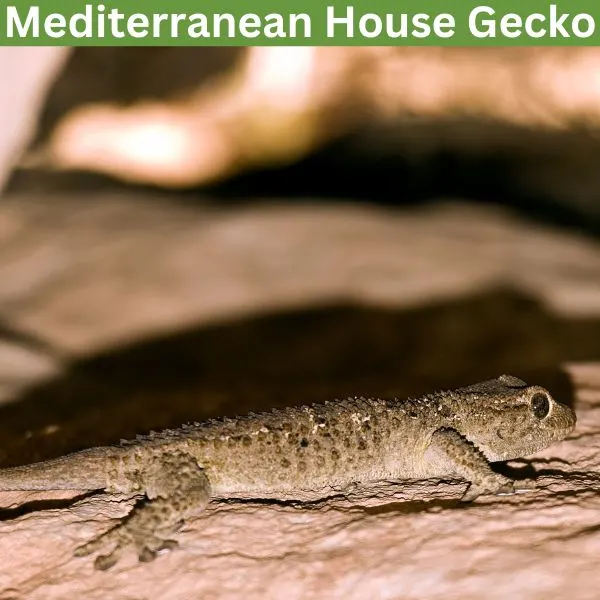
- Experience Level: Beginners
- Family: Gekkonidae
- Scientific Name: Hemidactylus turcicus
- Other Names: Moon Lizard, Turkish Gecko
- Adult Size: 4 to 5 in. (10 to 13 cm.)
- Lifespan: 3 to 9 years
- Average Price Range: $10
The Mediterranean house gecko is an invasive species to Utah, and the United States. These lizards like their name suggests are native to the Mediterranean region, northern Africa, and the western portion of the Middle East. Mediterranean house geckos are common areas near homes, and around warehouses.
These geckos are a small species, with pads on their feet to help them climb. They have a tannish, or cream coloring, with dark spots on them, and very granular skin. The eyes of the Mediterranean house gecko are large, and give them excellent night vision.
Mediterranean house geckos are ready to breed when they reach four months to a year old. They use chirping, and clicking sounds to communicate with each other, and attract mates. April to August is when these lizards breed, and they lay around one to two eggs a clutch.
At night these lizards spend their time climbing on walls, and feeding insects to feed on. Mediterranean house geckos feed on things like grasshoppers, roaches, spiders, beetles, moths, and snails. These geckos are often seen near light sources, and other areas that attract insects.
Eublepharidae
25. Western Banded Gecko

- Experience Level: Beginner
- Family: Eublepharidae
- Scientific Name: Coleonyx variegatus
- Other Names: n/a
- Adult Size: 4 to 6 in. (10 to 15.24 cm.)
- Lifespan: 5 to 8 years
- Average Price Range: $60
Western banded geckos are native to the southwestern United States. These lizards live in sagebrush desert, woodlands, creosote bush, and chaparral habitats. They are found in open, and semi-arid habitats like grasslands, and open deserts.
The western banded gecko has a sandy yellowish, or tan appearance, with silky skin. They have yellow eyes that are very noticeable. These lizards have yellowish, gray, cream, or pink bands, and spots on them.
Western banded geckos breed throughout spring to fall, and lay between one to three clutches of eggs in the year. Their clutches can have up to two eggs, which take about 45 days to hatch.
Active at night, western banded geckos use their great eyesight to find and catch invertebrate prey. They feed on insects, spiders, and even scorpions. Predators of these species include tarantulas, larger reptiles, foxes, coyotes, and birds. To defend itself this lizard will use its camouflage, or curl its tail to mimic a scorpion.
26. Common Leopard Gecko

- Experience Level: Beginner
- Family: Eublepharidae
- Scientific Name: Eublepharis macularius
- Other Names: n/a
- Adult Size: 7.1 to 11 in. (18 to 28 cm.)
- Lifespan: 15 years
- Average Price Range: n/a
Common leopard geckos are an invasive species in Utah. They are originally found in Afghanistan, India, Pakistan, Nepal, and Iran. Common leopard geckos live in semi-arid, and arid environments. In their native range they live in sandy, and sparsely vegetated habitats.
Leopard geckos are small lizards that get their name after the dark leopard-like markings that appear over their body. The spots that cover this lizard may vary from being very prominent, to hard to see.
Common leopard lizards breed in the summer, and females lay around 6 to 8 eggs in a clutch. These lizards are one of the most common species kept as a pet, which is what caused them to become invasive. Captive common leopard lizards have various colors, and patterns due to selective breeding.
Leopard lizards have very 100 tiny teeth, which help them hold onto their prey. These lizards use their coloring and patterns on them to remain hidden from predators. These lizards can also detach and grow back their tail.
Xantusiidae
27. Desert Night Lizard

- Experience Level: Intermediate
- Family: Xantusiidae
- Scientific Name: Xantusia vigilis
- Other Names: n/a
- Adult Size: 3 to 5.2 in. (7.62 to 13 cm.)
- Lifespan: 8 to 10 years
- Average Price Range: $300
The desert night lizard is native to Utah, found in the extreme southwestern region of the state. These lizards are found in semi-arid desert environments. They are often sighted near Joshua tree, and desert scrub habitats. From late April until the end of fall is when these are active.
Desert night lizards are medium-sized, with yellow, bray, brown, or olive coloring. They have a mottled dark pattern covering them. Males of these species have lighter colors, and are slightly smaller. These lizards have roughly keeled scales that are small.
Desert night lizards give birth to around 1 to 2 live young, and they breed in the fall. These lizards rely heavily on a healthy diet to give them the energy to breed. Small insects, spiders, and other types of arthropods are what these lizards eat.
The desert night lizard is active in the day unlike what its name suggests. These lizards will come together in groups up to 20 to hibernate together in the winter. Desert night lizards are common in their range, and have a stable population.
FAQ
Can you take a lizard from the wild in Utah?
In the wild you should not take a lizard from the wild unless you have the correct permit if needed, and know what lizard you have. Some of the lizards in the state like the Gila Monster are a protected species, and cannot be taken. You should look at the state’s laws, and if a species is protected, has catch limits, and if you need a permit to catch them in the wild if you want to obtain wild lizards.
In Utah are the most common lizard species?
Utah is filled with habitats that are perfect terrains for lizards to thrive. There are several common species that live in the state which include western skinks, sagebrush lizards, plateau lizards, and fence lizards.
Are there any dangerous lizards in Utah?
The Mojave in Utah is where the gila monsters live, and they are the only venomous lizard in the United States. Gila monsters are very rare, and if they bite you may need treatment but they are not usually deadly. Lizards are typically harmless to humans, and they will generally flee if approached.
Wrapping up
Utah has a myriad of lizard species that you may find across the state. When you know where, and when lizards are active, it becomes much easier for you to encounter rhythm in the wild. Some lizards even make good pets, and you should thoroughly research them before attempting to buy one.
Lizards in Utah are important animals, and the habitats they live in should be protected to prevent them from losing populations. Urbanization, pollution, and climate change are common threats lizards face, along with their natural predators. Learning about these species can make it possible for society to protect, and preserve them in the state.
More lizards in nearby states
